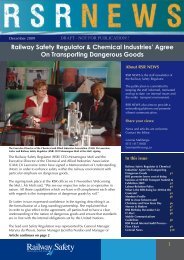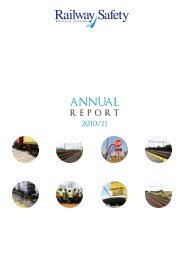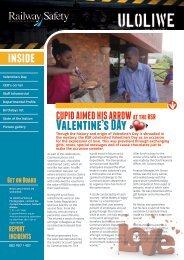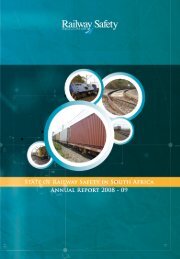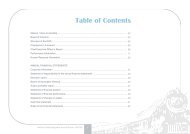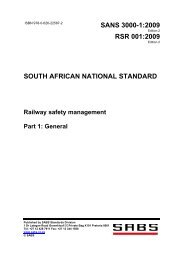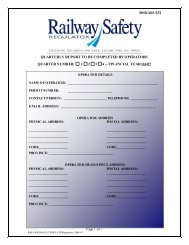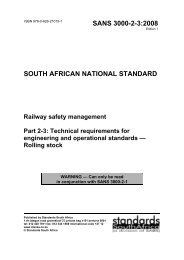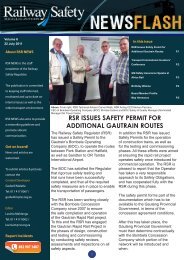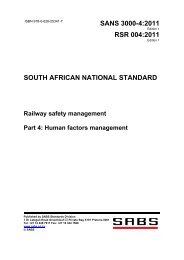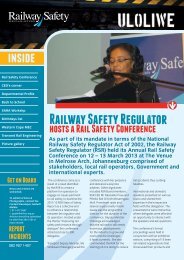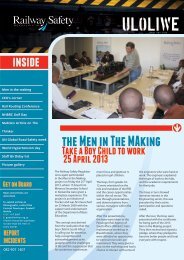ANNUAL REPORT 2005/2006 - Railway Safety Regulator
ANNUAL REPORT 2005/2006 - Railway Safety Regulator
ANNUAL REPORT 2005/2006 - Railway Safety Regulator
- No tags were found...
Create successful ePaper yourself
Turn your PDF publications into a flip-book with our unique Google optimized e-Paper software.
<strong>ANNUAL</strong> <strong>REPORT</strong> <strong>2005</strong>/<strong>2006</strong>
Mission StatementTo provide for and promote saferailway operations in a responsibleand supportive manner by applyingbest practice principles.Annual Report - 50
TABLE OF CONTENTSPART I:Legislative Mandate ............................................................................. 02Board of Directors................................................................................ 02Structure of the RSR ............................................................................ 03Chairperson’s Report............................................................................. 04Chief Executive Officer’s Report ............................................................. 06Performance Report.............................................................................. 09Human Resource Tables ........................................................................ 17State of <strong>Railway</strong> <strong>Safety</strong> Report Summary................................................... 25PART II:<strong>ANNUAL</strong> FINANCIAL STATEMENTSCorporate Information…………………………………………………………………………………… 30Corporate Governance Statement………………………………………………………………… 31Statement of Responsibility……..…………………………………………………………………… 31Report of the Auditor-General………………………………………………………………….…… 32Audit Committee Report……………………………………………………………………………… 34Directors’ Report…………………………………………………………………………………………… 35Statement of Financial Position…………………………………………………………………… 36Statement of Financial Performance……………………………………………………………… 37Statement of Changes in Net Assets……………………………………………………………… 38Cash Flow Statement………………………………………………………………………………………… 39Notes on the Annual Financial Statements…………………………………………………… 40Annual Report -
Legislative MandateBoard Of DirectorsAnnual Report - The legislative mandate of the <strong>Railway</strong> <strong>Safety</strong> <strong>Regulator</strong> and itsstrategic planning is influenced by the following laws:• National <strong>Railway</strong> <strong>Safety</strong> <strong>Regulator</strong> Act, 2002(Act No. 16 of 2002)• Companies Act, 1973 (Act No. 61 of 1973)• Public Finance Management Act, 1999 (Act No. 1 of 1999)• National Land Transport Transition Act, 2000(Act No. 22 of 2000)• Labour Relations Act, 1995 (Act No. 66 of 1995)• Basic Conditions of Employment Act, 1997(Act No. 75 of 1997)• Skills Development Act, 1998 (Act No. 97 of 1998)• National Archives of South Africa Act, 1996(Act No. 43 of 1996)• Promotion of Access to Information Act, 2000(Act No. 2 of 2000)• Occupational Health and <strong>Safety</strong> Act, 1993(Act No.85 1993)• Promotion of Administrative Justice Act, 2000(Act No. 3 of 2000)• Employment Equity Act, 1988 (Act No. 55 of 1998)• Compensation for Occupational Injuries andDiseases Act, 1993 (Act No. 130 of 1993)The <strong>Railway</strong> <strong>Safety</strong> <strong>Regulator</strong> is governed by a Board of Directorsappointed by the Minister of Transport in terms of the National<strong>Railway</strong> <strong>Safety</strong> <strong>Regulator</strong> Act, 2002 (Act No. 16 of 2002). The Boardis chaired by a non-executive director, Mr Sipho Madonsela, and iscomprised of nine (9) non-executive directors with one executivedirector who is the Chief Executive of the <strong>Regulator</strong>. In line with therules of good corporate governance and the King II Commissionrecommendations, the roles of the Chairperson and the ChiefExecutive are separate.During its tenure, the board has established five committees,namely, <strong>Railway</strong> <strong>Safety</strong> Committee, Human Resources andRemuneration Committee, Communication Committee, AuditCommittee and Finance Committee.The committees are vehicles through which the Board pays closerattention to the detailed work of the <strong>Regulator</strong> and process allcritical issues before these are dealt with bya full Board.Standing (Left to Right):Ms Kethabile Mabe( Board Secretary), Mr Senny van den Oever, Mr Mawethu Vilana, MrMosenngwa Mofi (Acting CEO), Assistant Commissioner Willem Venter, Mr Jacob MalatseSeated (Left to Right):Ms Nonhlanhla Mkhwanazi, Mr Sipho Madonsela (Chairperson), Ms May Hermanus, MrDavid Sekgobela and Mr Phillip van Heerden
Structure of the RSRMosenngwa MofiActing Chief ExecutiveK MabeGeneral Manager LegalServicesS KhosaChief FinancialOfficerM du PlessisGeneral Manager<strong>Safety</strong> RegulationR MzaidumeGeneral ManagerCorporate AffairsH BruwerGeneral Manager<strong>Safety</strong> AssuranceM MofiGeneral ManagerSupport ServicesAnnual Report -
Chairperson’s ReportThe past year has marked significant progress in the institutionaldevelopment of the <strong>Railway</strong> <strong>Safety</strong> <strong>Regulator</strong>. The Board of Directors movedwith speed in its drive to ensure that the RSR fulfilled its mandate as outlinedin the National <strong>Railway</strong> <strong>Safety</strong> <strong>Regulator</strong> Act, 2002 (Act No. 16 of 2002).Through the development of the necessary capacity to undertake the day today responsibilities of the organisation, the Board has successfully laid downa solid foundation for the RSR to execute its mandate as a fully functionalinstitution.Annual Report - Safe railway operations are not only vitalto the national economy, but also to theeconomic viability of the operators suchas Spoornet. Train accidents cause humansuffering, huge financial losses and disruptionto crucial services. Moreover, the usersof the rail system, both passengers andfreight consignors, need the assurancethat the transportation of persons andgoods, including dangerous and heavy haulcommodities will be conveyed in the mostefficient, effective and safe manner.The RSR’s annual State of <strong>Railway</strong> <strong>Safety</strong>Report, although not exhaustive in itsanalysis due to shortcomings in the reportingsystem, reflects no improvement in themeasured categories of safety for the yearunder review. This is significant in that itposes major challenges for the <strong>Railway</strong><strong>Safety</strong> <strong>Regulator</strong> in ensuring railway safety.Despite this poor performance, railwaysafety should remain a primary focal point byoperators, and greater effort must be madeto ensure that a safety culture is entrenchedin the way operators conduct their business.In our quest to entrench a safety culturein the railways, the RSR has laid downthe critical foundation for a regulatedenvironment through the promulgation of the<strong>Safety</strong> Management System Regulations andthe publishing of the South African NationalStandards 3000-1 (SANS 3000-1: GeneralStandards).During the year under review, the RSR wasable to convert Temporary <strong>Safety</strong> Permitsissued in 2004 to <strong>Safety</strong> Permits. Reasonable
capacity has now been created to audit operators’ compliance withthe law, and this marks a significant development in the scope of theRSR’s work, as the <strong>Regulator</strong> will now be able to pay more attentionto compliance monitoring. The significance of this is that it positionsthe RSR to play a much more proactive role in its drive to ensure thatrailway operators comply with safety standards.The work of the Board in the year under review focused primarilyon developing the RSR as a fully fledged institution with requisitecapacity to deliver on its mandate, as well as strengthening theregulatory framework. However, we have also been able to respondto a number of railway occurrences, with the most prominent beingthe collision between the Blue Train and the Trans-Karoo Train.The RSR’s responses were primarily through instituting Boards ofInquiry to investigate these railway accidents. These interventionsrepresented critical milestones in the RSR’s institutional growth anddevelopment as the RSR was now able to recommend correctivemeasures to be taken by operators based on the findings of therailway occurrence investigations.RSR and staff for the excellent work done in the past year. I mustfurther express a profound word of appreciation to the sterling workof the former acting CEO, Mr Stanley Khosa, and the current actingCEO, Mr Mosenngwa Mofi, who have been instrumental in creating therobust organisation the RSR has become.A lot of work still lies ahead, and I am certain that the organisationwill rise to the occasion and live up to expectations.SE MadonselaCHAIRPERSONNotably, the most significant development in this area is theestablishment of the <strong>Railway</strong> <strong>Safety</strong> Inspectorate that will play acentral role in ensuring safety compliance and monitoring adherenceto standards, through safety audits, inspections and occurrenceinvestigations. Significant progress was also made in appointing theexecutive management team and the subsequent appointment ofstaff in key positions across the organisation.Finally, I would like to express my appreciation and special thanks toMinister Jeff Radebe for his support and leadership during the tenureof this Board, whose term comes to an end early in the new financialyear. I also wish to extend my appreciation to the entire Board of theAnnual Report -
Chief Executive Officer’s ReportThe year under review represents a period when the work of the organisationgot underway in earnest with numerous strides towards the realisation of aninstitutional arrangement that is fully responsive to its statutory mandatewith the requisite capacity.Annual Report - Numerous activities which had significantimpact on the state of railway safety in thecountry took place and will be reflected indetail in the annual State of <strong>Railway</strong> <strong>Safety</strong>Report developed pursuant to section 20(1)of the National <strong>Railway</strong> <strong>Safety</strong> <strong>Regulator</strong> Act,2002, which will be published during thecourse of <strong>2006</strong>.Creation of the Regulated EnvironmentFollowing the promulgation of the <strong>Safety</strong>Management System Regulations in 2004,the <strong>Regulator</strong> was able to publish the firstin a series of railway safety standards,SANS 3000-1, which set the stage for theimplementation of a new railway safetymanagement environment. These standardshave been developed with a view to achieveuniformity in the management of railwaysafety, both as a general principle and in theassessment of the performance of operatorsbased on their safety management system.In the coming year the RSR will develop thesecond in the series of standards which willfocus on the general technical requirementsas well as human factor management.In 2004, Temporary <strong>Safety</strong> Permits wereissued to all identified bona fide railwayoperators. From September <strong>2005</strong>, these wereeffectively replaced by <strong>Safety</strong> Permits with athree year validity period to all operators whomet the minimum requirements in terms ofSANS 3000-1.In ensuring that railway safety is enhanced,the process of converting temporary permitsproceeded in earnest and a total of 197permits were issued by March <strong>2006</strong>. Themajority of operators who are required bylaw to apply for permits submitted their<strong>Safety</strong> Management System reports.Creation of a Safe <strong>Railway</strong> EnvironmentThe envisaged transfer of Metrorail fromTransnet to the South African Rail CommuterCorporation (SARCC) and the subsequentconsolidation of Metrorail and the SARCCinto a single entity will present a particularchallenge to the <strong>Regulator</strong> as permits arenot transferable, and the SARCC has toapply for a new permit. This arrangementwill signal a significant shift in that the
SARCC will fall directly under the RSR’s regulatory authority, as itwill now be responsible for railway operations, while in the pastonly Metrorail was subject to such authority. The consolidationof infrastructure ownership and operations will ensure better coordinationof activities, better allocation of resources and a morestreamlined institutional accountability on matters of railway safetyand operational efficiency.As at the end of the year under review, the <strong>Regulator</strong> had been ableto respond effectively to a number of occurrences that warrantedattention. Four (4) Boards of Inquiry were commissioned toinvestigate serious occurrences, namely, Merafe Halt, Deelfontein(Blue Train/Trans-Karoo), Groot Marico and Kinross. Occurrenceinvestigations have now become a regular feature of the <strong>Regulator</strong>’sactivities since creating the necessary capacity (both internal andexternal) to undertake this task.The <strong>Regulator</strong> had further taken steps to develop capacity toundertake safety audits and inspections through the appointment ofthe <strong>Railway</strong> <strong>Safety</strong> Inspectorate and the creation of a database ofexperts to conduct safety audits and investigations.It is anticipated that the <strong>Regulator</strong> will significantly increase itscapacity as it proceeds to develop regulations and standards,conducting occurrence investigations, audits and inspections, anddeploys the national railway safety information and monitoringsystem. In addition, specific targeted interventions are plannedwhich includes those aimed at addressing problems associatedwith level crossings, trespassing, unlawful settlements, crime andtransportation of dangerous goods by rail.Key Developments and ChallengesThe adoption of the National Freight Logistics Strategy by Cabinetin <strong>2005</strong> represents a significant challenge in the positioning of the<strong>Regulator</strong> and its approach to industry regulation. The strategyenvisages the introduction of competition in the rail sector, byallowing open access to the secondary network for licensed operatorsand the incremental introduction of non-discriminatory accessand pricing on the primary network. In this regard, the RSR will,among others, have to determine safety regulations regardingclass of access to specific lines, operating standards, line quality,allowable access, interoperability standards and the qualification andassessment of safety standards of licensed operators.The Gautrain Rapid Rail Link Project also presents a major safetyregulation challenge for the RSR. The project will bring with it uniquetechnology and operating parameters for South Africa. The challengefor the <strong>Regulator</strong> is to evaluate the project from a safety perspective,through ensuring that due process is followed in the development ofstandards. The RSR will actively participate in the project planning,detailed design and implementation phases of this project, with aparticular focus on safety standards. Ultimately, the <strong>Regulator</strong> will berequired to issue a safety permit, once satisfied that a comprehensiveand fully documented safety management system is in place.The need for harmonisation of safety standards within the SouthernAfrica Development Community (SADC) region is critical andconstitutes a significant part of the <strong>Regulator</strong>’s mandate. As the onlyrailway safety regulator in the region, and indeed on the continent,it is incumbent upon the RSR to play a lead role in realising theharmonisation of railway safety standards envisaged in the SADCProtocol on Transport, Communications and Meteorology.During the year under review, the <strong>Regulator</strong> has firmly put in place asolid foundation for an effective railway safety regime that will go along way in turning the tide in the state of safety in our railways.Transportation of Dangerous GoodsThe <strong>Regulator</strong>’s Enabling Act mandates the RSR to act as acompetent authority on the transportation of dangerous goods byrail. The RSR has now created the necessary capacity to establishthe regulatory framework for the transportation of dangerous goodsby rail. Research will get underway in the next financial year with aview to developing the appropriate standards for transportation ofdangerous goods by rail in the country.Particular attention will be given to the existing dangerous goodsrail standard SANS 10232-2 (Operational Requirements for theTransportation of Dangerous Goods by Rail), which was neverimplemented.Annual Report -
<strong>Railway</strong> <strong>Safety</strong> AuditsFollowing a successful training programme undertaken by theInspectorate, an interim <strong>Safety</strong> Management System (SMS) AuditProtocol was developed. This protocol will be further refined toaccurately determine the risk profiles of the operators to be audited.The audits on both Spoornet and Metrorail are currently underwayand will be concluded during the first quarter of the <strong>2006</strong>/2007financial year.State of <strong>Railway</strong> <strong>Safety</strong>The State of <strong>Railway</strong> <strong>Safety</strong> Report for <strong>2005</strong>/<strong>2006</strong> indicates thesignificant challenges the RSR is facing going forward. Some of theconclusions drawn by the report reflect the following:• The state of railway safety and security is not improving• Costs associated with railway occurrences are dramaticallyincreasing and impact negatively on the cost of doing business• The risk profile of major operators is high and has a bearing on thecosts associated with risk• There is a general negative perception about the state of safety andoperational efficiency in the rail sector in the country• The state of railway infrastructure is appalling and is one of themajor contributors to the deteriorating state of safety in therailways.necessary technical and regulatory capacity, to enable the <strong>Regulator</strong>to effectively and competently execute its mandate, was developed.Crucial organisational systems, including institutional policies andpractices have been put in place to ensure compliance with the PublicFinance Management Act, 1999 (Act No. 1 of 1999) as amended, andother relevant laws.The RSR is now geared to enter the next phase of its development,being the consolidation and strengthening of its regulatory capacity.The coming year should see a much more focused and sustainedapproach towards the development of a railway safety regime that isfully responsive to South Africa’s national imperatives and one thatensures operator efficiency through, among others:• Strengthening the regulatory framework through the furtherdevelopment of regulations and standards.• Strengthening the RSR’s monitoring and compliance functionthrough conducting safety audits, inspections, occurrenceinvestigations and monitoring the implementation of recommendedcorrective actions.• Improving state of railway safety reporting through ensuringimproved and standardised reporting by operators thereby enablingbetter analysis by the RSR and• Strengthening institutional development through soundhuman capital management and development, sound financialmanagement, sound management information systems support,sound corporate governance and an improvement in theorganisation’s profile.ConclusionAnnual Report - The <strong>2005</strong>/<strong>2006</strong> financial year saw acceleration in the implementationof the <strong>Regulator</strong>’s organisational establishment which included theappointment of General Managers and staff to execute the mandateof the organisation. The most pervasive challenge for the comingfinancial year is the acceleration of the process to populate theestablishment to create the requisite capacity for the <strong>Regulator</strong> toeffectively execute its mandate in a sustainable manner.Mosenngwa MofiACTING CHIEF EXECUTIVEIn further advancing the RSR’s institutional development, the
Performance Report7.1. SAFETY REGULATION...................................................................... 107.2. SAFETY ASSURANCE ....................................................................... 127.3. SUPPORT SERVICES......................................................................... 147.4. FINANCE ........................................................................................ 157.5. LEGAL SERVICES............................................................................. 157.6. CORPORATE AFFAIRS ..................................................................... 16Annual Report -
Performance Report7.1 <strong>Safety</strong> RegulationObjectivesOutputsOutput PerformanceMeasures/serviceDelivery IndicatorsActual Performance Against TargetTarget Actual NotesDevelopment andimplementation of railwaysafety regulationsDevelopment of safety managementsystems and reports by railwayoperators<strong>Safety</strong> Management Systemreports in place and submittedto the RSROctober<strong>2005</strong>All operators who have been issuedwith <strong>Safety</strong> Permits have submitted<strong>Safety</strong> Management System reportsas confirmation that their systemsare in place.Development andimplementation of railwaysafety regulationsDraft two (2) prioritised railwaysafety regulations as outlined in theRSR ActDraft Regulations published forcommentMay <strong>2006</strong>Initial research on the draftregulations covering exemptionsand permit fees was done. Targetfor publication will not be met.Draft regulations willbe published duringthe third quarter of<strong>2006</strong>/7.Development of railsafety standardsDraft Regulations for thedevelopment of standards, outlininga set process for developing railsafety standardsPublication of regulations forcommentJuly <strong>2006</strong>Draft regulations have beenpublished for comment on 30 August<strong>2005</strong> in Government Notice No. 862.Development of railsafety standardsDraft South African NationalStandards 3000-2, outlining thegeneral requirements for technicalstandards for safety and operationalstandardsPublication of SANS 3000-2standardsJuly 2007Draft standards have been developedand will be subjected to due processenvisaged in the Draft Regulationson development of standardsDevelopment of railsafety standardsRecognise and develop an MOUwith an industry association towork jointly with the RSR on thedevelopment of safety standardsA recognised industryassociation to work with theRSR on the development ofsafety standardsOctober<strong>2005</strong>The Rail-Road Association has beenrecognised as an industry associationto work jointly with the RSR on thedevelopment of standards, and anMOU has been signed in this regard.Issue <strong>Safety</strong> PermitsEvaluate, assess safetymanagement system plans andreports in order to decide on thegranting of <strong>Safety</strong> PermitsAssessment of <strong>Safety</strong> Permitapplications completedSeptember<strong>2005</strong><strong>Safety</strong> Management Plans assessedand evaluated for purposes ofgranting <strong>Safety</strong> Permits to operators.Annual Report - 10Issue <strong>Safety</strong> PermitsReplace the current Temporary<strong>Safety</strong> Permits through the issuingof <strong>Safety</strong> Permits<strong>Safety</strong> Permits issuedSeptember<strong>2005</strong>180 <strong>Safety</strong> Permits were issued toreplace Temporary Permits as ontarget date. As at the end of theyear under review, a total of197 <strong>Safety</strong> Permits were issued.
Performance ReportObjectivesOutputsOutput PerformanceMeasures/serviceDelivery IndicatorsActual Performance Against TargetTarget Actual NotesA fee structure for theissuing of <strong>Safety</strong> PermitsDevelop draft model on the feestructure for the issuing of <strong>Safety</strong>PermitsDraft fee structure modelin placeJune <strong>2006</strong>Fee Structure model not yetdeveloped due to initial capacityconstraints and target will notbe met.Fee structure modelwill be put in placeduring third quarterof the <strong>2006</strong>/7financial yearHarmonisation of <strong>Railway</strong><strong>Safety</strong> amongst SADCcountriesResearch and establishment of aforum with SADC countriesInvestigation into a forum forharmonisation of rail safetywithin SADC countriesAugust<strong>2006</strong>No progress made due to initialcapacity constraints.SADC Forum will beinaugurated duringthird quarter the<strong>2006</strong>/7 financial yearResearch into thetransportation ofdangerous goods by railwith a view to developregulations and standardsCommission a research study on thetransportation of dangerous goodsby rail.Research report ontransportation of dangerousgoods finalised.March <strong>2006</strong>No progress made due to initialcapacity constraints.Research report willbe finalised duringthe second quarter of<strong>2006</strong>/7.Research into thesafety of level crossingswith a view to developstandardsCommission a research study onthe safety of level crossings andthe number of occurrences in thecountry.Research report on levelcrossings.October<strong>2005</strong>Research study on level crossingsundertaken and finalised.A database of railwayoperatorsDetermine the number of railwayoperators operating in the country.A database for railwayoperators in place.December<strong>2005</strong>A database of railway operatorsdeveloped and in place.Memorandum ofUnderstanding witha recognised railwayindustry associationDevelop a memorandum ofunderstanding with a recognisedrailway industry association.A memorandum ofunderstanding with arecognised industry associationin place.September<strong>2005</strong>A memorandum of understandingentered into with the Rail-RoadAssociation as a recognised industryassociation.Co-operative Agreementswith relevant governmentdepartments/stateagenciesEnter into Cooperative Agreementswith SAPS and Department ofLabour.Cooperative Agreementsin place.August<strong>2006</strong>Draft Memoranda of Understandingas a precursor to CooperativeAgreements with SAPS andDepartment of Labour developed.Co-operativeAgreements will be inplace during the lastquarter the <strong>2006</strong>/7financial year.Annual Report - 11
Performance Report7.2 <strong>Safety</strong> AssuranceObjectivesOutputsOutput PerformanceMeasures/service DeliveryIndicatorsActual Performance Against TargetTarget Actual NotesEnsure compliance withthe safety regulationregimeConduct occurrence andaccident investigationsOccurrence and accidentinvestigations conductedOngoingFour (4) major railway occurrenceinvestigations conducted and finalised.They are as follows:• Merafe Halt: Rear-end passenger traincollision on 13/07/<strong>2005</strong> between twoMetrorail passenger trains• Deelfontein: Head-on passenger traincollision on 26/10/<strong>2005</strong> between the Bluetrain and the Trans-Karoo• Groot Marico: Major goods train derailmenton 30/10/<strong>2005</strong> near Groot Marico whichled to the fatal injury of the train driver.• Kinross: Major goods train derailment nearKinross on 17/01/<strong>2006</strong> with subsequentspillage of 480,000 litres of hazardousmaterial.Reports on investigationfindingsOngoingDuring the period under review only theMerafe Halt and Deelfontein occurrenceinvestigation reports were finalised andadopted by the Board on 9 February <strong>2006</strong>Annual Report - 12
Performance Report7.2 <strong>Safety</strong> AssuranceObjectivesOutputsOutput PerformanceMeasures/service DeliveryIndicatorsActual Performance Against TargetTarget Actual NotesImplementation of correctivemeasures stemming frominvestigation reportsOngoingThe Inspectorate, being the body responsiblefor ensuring implementation of correctivemeasures from investigation reports wasonly established in January <strong>2006</strong>Ensure compliance withthe safety regulationregimeConduct inspectionsand audits to determinecompliance with the safetyregulations and standardsInspection and audit reports Ongoing Audits on Spoornet and Metrorail <strong>Safety</strong>Management Systems (SMSs) were initiated.Inspections have not yet been conducted.Regular reporting onrailway occurrences andincidentsUp-to-date and reliableinformation on railwayoccurrences and incidentsQuarterly reports on railwayoccurrences and incidentsOngoingQuarterly reports on railway occurrences andincidents produced.Reports on the stateof safety in the railwayindustryDevelopment of Annual Stateof <strong>Safety</strong> reports, identifyinghigh level safety risks inrailway operationsAnnual State of <strong>Safety</strong> reportMarch<strong>2006</strong>Annual State of <strong>Safety</strong> report produced.Identification of high levelsafety risks in railwayoperationsMarch<strong>2006</strong>High level safety risks in railway operationsidentified in the State of <strong>Safety</strong> report.Annual Report - 13
Performance Report7.3 Support ServicesAnnual Report - 14ObjectivesA National InformationMonitoring System toenable effectivemanagement andmonitoring of railwaysafetyHuman ResourceManagement policiesand proceduresRecruitment andselection of competentstaffRecruitment andselection of competentstaffA training,development andorientation programmefor critical positionsTo develop acohesive, performanceoriented RSR teamOutputsDevelop a National InformationMonitoring SystemDevelop conditions and terms ofemployment for the RSR.Develop and implement HR policiesand procedures.Output PerformanceMeasures/serviceDelivery IndicatorsA National InformationMonitoring System in placeand fully functionalEvaluations and salary bandscompleted.HR policies developed.Actual Performance Against TargetTarget Actual NotesMay <strong>2006</strong>September<strong>2005</strong>September<strong>2005</strong>Appointment of staff Critical positions filled November<strong>2005</strong>Develop a training and orientationprogramme for critical staff with aparticular focus on the inspectorate.Develop performance agreementsfor the executive team.Training and orientationprogramme in place andimplemented.Achievement of the objectivesof the business planMarch<strong>2006</strong>October<strong>2005</strong>First phase of system development isunderway, which is looking at thedetermination of user requirementsand a Project Team is n place todrive the project. Target will not bemet.Conditions and terms of employmentin place. Evaluations and salarybands have been completed.Human Resource Managementpolicies developed and approved bythe Board.All critical positions have been filledincluding the establishment of theInspectorate.Training and orientation programmefor the Inspectorate implemented.Draft performance agreements havebeen developed and implementationof business plan is underway.Development of thesystem will getunderway during thethird quarter of the<strong>2006</strong>/7 financial yearTraining of othercritical staff will getunderway duringsecond quarter of the<strong>2006</strong>/7 financial year.The majority ofmembers of theExecutive Committeewere appointedduring the latterpart of <strong>2005</strong>/6 andall performanceagreements will be inplace by second quarterof <strong>2006</strong>/7.
Performance Report7.4 FinanceObjectivesOutputsOutput PerformanceMeasures/serviceDelivery IndicatorsActual Performance Against TargetTarget Actual NotesReview and developfinance, procurement,IT and organisationalproceduresReview and develop the followingkey procedures;• Internal control measures• Financial procedures• Procurement Policy• IT & Information systems• S&T PolicyOrganisational Systems andprocedures in place.December<strong>2005</strong>Organisational systems, policies andprocedures have been developedand are in place. Procurement andFinancial Delegation have beenexecuted by the Board. The followingpolicies were approved:• Cash Management Policy• Investment Policy• Fixed Asset Management Policy• Procurement Policy7.5 Legal ServicesObjectivesOutputsOutput PerformanceMeasures/service DeliveryIndicatorsActual Performance Against TargetTarget Actual NotesTo ensure soundcorporate governanceEnsure effective and soundfunctioning of organisationalstructures, streamlining ofdecision-making as well as theeffectiveness Board committees.Compliance with corporategovernance requirements aswell as the PFMA.September<strong>2005</strong>Board and its structures in place andfully functional within the definedrules of good corporate governance.To ensure alignment withDepartment of Transport’sstrategic directionDevelop Performance Agreementbetween Board and MinisterPerformance Agreement inplace and implemented.September<strong>2005</strong>Shareholder compact with theMinister of Transport signed. DraftPerformance Agreement with theDepartment of Transport in place.PerformanceAgreement will beimplemented onceapproval by theMinister has beensecured.Annual Report - 15
Performance Report7.6 Corporate AffairsObjectivesTo create publicawareness on railwaysafetyTo develop a cohesive,performance orientedRSR teamOutputsDevelop and implement internaland external Communication andEducation Strategy for the industry,commuters and communitiesOutput PerformanceMeasures/service DeliveryIndicatorsThe extent of safety complianceby the railway operatorsThe level of safety awarenessby commuters andcommunitiesActual Performance Against TargetTarget Actual NotesMarch <strong>2005</strong>March <strong>2005</strong>Communication Strategy and Planapproved by the Board. Exhibitionsheld at strategic national andinternational events and liaison withvarious stakeholders ongoing.No progress due to initial capacityconstraints.Team building Team building exercise March <strong>2006</strong> No progress due to initial capacityconstraints and ongoing staffrecruitment.Develop Integrated Business/Strategic PlanAchievement of the objectivesof the Business PlanSeptember<strong>2005</strong>Strategic Plan developed.Structuredimplementation ofpublic awarenessprogrammes will getunderway duringsecond quarter of<strong>2006</strong>/7 financialyear.Structuredimplementation ofpublic awarenessprogrammes will getunderway duringsecond quarter ofthe <strong>2006</strong>/7 financialyear.Team buildingexercise will getunderway duringthird quarter of<strong>2006</strong>/7 financialyear.Annual Report - 16
Human Resource Tables8.1 PERSONNEL EXPENDITURE................................................................ 188.2 EMPLOYMENT AND VACANCIES – APRIL <strong>2005</strong> TO MARCH <strong>2006</strong>......... 198.3 JOB EVALUATION APRIL <strong>2005</strong> TO MARCH <strong>2006</strong>................................. 208.4 <strong>ANNUAL</strong> TURNOVER – APRIL <strong>2005</strong> TO MARCH <strong>2006</strong> ........................ 208.5 EMPLOYMENT EQUITY – APRIL <strong>2005</strong> TO MARCH <strong>2006</strong>...................... 218.6 LEAVE UTILISATION – APRIL <strong>2005</strong> TO MARCH <strong>2006</strong>....................... 23Annual Report - 17
Human Resource TablesTABLE 8.1 - Personnel ExpenditureCost CentreTotal Expenditure(R’000)PersonnelExpenditure (R’000)TrainingExpenditure (R’000)Professional Service(R’000)Personnel Costas a % of TotalexpenditureSupport Services 3,381,463.80 691,056.64 11,644.00 1,118,109.70 20.43%CEO 513,583.24 359,049.13 2,972.14 21,960.00 69.91%Finance 9,193,275.10 1,525,320.41 5,702.44 1,057,815.71 16.59%Corporate Affairs 1,455,088.70 359,473.51 2,972.14 5,444.60 24.70%Legal Services 1,203,785.10 843,739.23 29,257.30 41,910.72 70.09%<strong>Safety</strong> Assurance 4,791,725.50 927,234.47 286,007.38 919,208.52 19.35%TABLE 8.1 PERSONNEL EXPENDITURE<strong>Safety</strong> Regulation 1,765,847.50 1,045,614.86 9,440.32 622,774.26 59.21%Total As On Financial System 22,304,768.94 5,751,488.25 347,995.72 3,787,223.51 25.78%Average Cost PerEmployee (R’000)375,718.2042,798.60656,662.50363,772.18300,946.30239,586.27147,154.002,126,638.05TABLE 8.1.2 - Salaries, Overtime, Home Owners Allowance and Medical Aid by Cost CentreCostCentreSalaries (R’000) Overtime(R’000)Overtime as of% PersonnelHOA (R’000)HOA as % ofPersonnel CostSupport Services 418,353.20 0 0 HOA not applicableCEO 321,566.71 0 0Finance 517,372.34 0 0Medical Ass.(R’000)Medical Ass. ofas % PersonnelTotal PersonnelCost (R’000)48,551.00 7.02% 691,056.640 0.00% 359,049.1346,141.00 3.02% 1,525,320.41Annual Report - 18Corporate Affairs 251,599.63 0 0Legal Services 294,060.45 0 0<strong>Safety</strong> Assurance 905,199.01 0 0<strong>Safety</strong> Regulation 784,430.29 0 0TOTAL 3,492,581.63 0 05,679.00 1.57% 359,473.510 0.00% 843,739.2345,755.00 4.93% 927,234.4731,766.00 3.03% 1,045,614.86177,892.00 3.09% 5,751,488.25
8.2 Employment and Vacancies – April <strong>2005</strong> To March <strong>2006</strong>TABLE 8.2.1 – Employment and Vacancies by Cost Centre at End Of PeriodCost Centre Number of Posts Number of Posts Filled Vacancy RateNumber of Posts FilledAdditional to the EstablishmentSupport Services 9 6 33% 0CEO 5 1 87% 0Finance 6 4 33% 0Corporate Affairs 4 1 75% 0Legal Services 4 2 50% 0<strong>Safety</strong> Assurance 21 12 43% 0<strong>Safety</strong> Regulation 12 10 17% 0TOTAL 61 36 41% 0TABLE 8.2.2 – Employment and Vacancies by Salary Band at End Of PeriodSalary Band Number of Posts Number of Posts Filled Vacancy RateNumber of Posts FilledAdditionalto the EstablishmentLower skilled (Levels 3), Permanent 2 1 50% 0Skilled (Levels 6-10), Permanent 19 11 42% 0Highly skilled production (Levels 11),PermanentHighly skilled supervision (Levels 12-13),PermanentSenior management (Levels 14-15),Permanent12 5 58% 019 11 42% 08 8 0% 0TOTAL 61 36 41% 0Annual Report - 19
8.3 Job Evaluation April <strong>2005</strong> To March <strong>2006</strong>Table 8.3.1 – Job EvaluationSalary BandNumber of PostsNumber of JobsEvaluation% of PostsEvaluationNumber of PostsUpgraded% of UpgradedPosts EvaluationLower skilled (Level 1-2) 0 0 0 0 0Skilled (Level 3-5) 2 2 0 0 0Number of PostsDowngraded% of DowngradedPosts Evaluation0 00 0Highly skilled production(Level 6-8)Highly skilled supervision(Levels 9-12)Senior managementservice Band ASenior Managementservice Band BSenior managementservices Band C16 16 0 0 029 29 0 0 06 6 0 0 07 7 0 0 01 1 0 0 00 00 00 00 00 0TOTAL 61 61 0 0 00 08.4 Annual Turnover – April <strong>2005</strong> To March <strong>2006</strong>Table 8.4.1– Annual Turnover Rates By Salary BandSalary BandEmployment at Beginningof PeriodAppointments Terminations Turnover RateLower skilled (Level 1-2), Permanent 0 0 0 0Skilled (Level 3-5), Permanent 0 1 0 0Annual Report - 20Highly skilled production (levels 6-8 ) Permanent 0 8 0 0Highly skilled supervision (Levels 9-12) 0 14 1 7%Senior management service Band A, Permanent 0 5 0 0Senior management service Band B, Permanent 0 7 0 0Senior management service Band C, Permanent 0 1 1 100%TOTAL 0 36 2 6%
Table 8.4.2 – Reasons Why Staff Are Leaving The <strong>Regulator</strong>Termination by TypeNumberPercentage of TotalResignationPercentage of TotalEmploymentTotal EmploymentDeath, Permanent 0 0% 0% 0Resignation, Permanent 2 100% 6% 36Expiry of contract, Permanent 0 0% 0% 0Dismissal-operational changes, Permanent 0 0% 0% 0Discharged due to ill health, Permanent 0 0% 0% 0Retirement, Permanent 0 0% 0% 0TOTAL 2 100% 6% 368.5 Employment Equity – April <strong>2005</strong> To March <strong>2006</strong>Table 8.5.1 – Total Number Of Employees (Incl. Employees With Disabilities) PerOccupational CategoryOccupational CategoriesLegislators, senior officials and managers,PermanentMaleAfricanMaleColouredMaleIndianMaleTotalBlackMaleWhite2 0 0 2 2FemaleAfricanFemaleColouredFemaleIndianFemaleTotalBlackFemaleWhiteTOTAL3 0 0 3 1 8Professionals, Permanent 4 0 1 4 3Clerks, Permanent 2 0 0 2 01 0 1 1 1 116 3 0 6 0 11Service and sales workers, Permanent 0 0 0 0 0Craft and related trades workers,PermanentPlant and machine operators andassemblers, Permanent0 0 0 0 00 0 0 0 0Elementary occupation, Permanent 0 0 0 0 0Other, Permanent 3 0 0 3 20 0 0 0 0 00 0 0 0 0 00 0 0 0 0 01 0 0 1 0 10 0 0 0 0 5Annual Report - 21
Employees With DisabilitiesMaleAfricanMaleColouredMaleIndianMaleTotalBlacksMaleWhiteEmployees with disabilities 0 0 0 0 0TOTAL 11 0 1 10 7FemaleAfricanFemaleColouredFemaleIndianFemaleTotalBlacksFemaleWhiteTotal0 0 0 0 0 011 3 1 11 2 36Table 8.5.2 – Total Number Of Employees (Incl. Employees With Disabilities) PerOccupational BandsOccupational BandsMaleAfricanMaleColouredMaleIndianMaleTotalBlackMaleWhiteTop Management, Permanent 2 0 0 2 2Senior Management, Permanent 2 0 0 2 1FemaleAfricanFemaleColouredFemaleIndianFemaleTotalBlackFemaleWhiteTotal3 0 0 3 1 80 0 1 0 1 5Professionally qualified and experiencedspecialsSkilled technical and academicallyqualified workers, PermanentSemi-skilled and discretionary decisionmaking, PermanentUnskilled and defined decision making,Permanent2 0 1 2 24 0 0 4 21 0 0 1 00 0 0 0 01 0 0 1 0 61 1 0 1 0 85 2 0 5 0 81 0 0 1 0 1TOTAL 11 0 1 11 711 3 1 11 2 36Annual Report - 22
Table 8.5.3 Recruitment April <strong>2005</strong> To March <strong>2006</strong>Occupational BandsMaleAfricanMaleColouredMaleIndianMaleTotalBlackMaleWhiteTop Management, Permanent 2 0 0 2 2Senior Management, Permanent 2 0 0 2 1FemaleAfricanFemaleColouredFemaleIndianFemaleTotalBlackFemaleWhiteTotal3 0 0 3 1 80 0 1 0 1 5Professionally qualified and experiencedspecialsSkilled technical and academicallyqualified workers, PermanentSemi-skilled and discretionarydecision making, PermanentUnskilled and defined decisionmaking, Permanent2 0 1 2 24 0 0 4 21 0 0 1 00 0 0 0 01 0 0 1 0 61 1 0 1 0 85 2 0 5 0 71 0 0 1 0 1TOTAL 11 0 1 11 711 3 1 11 2 368.6 Leave Utilisation – April <strong>2005</strong> To March <strong>2006</strong>Table 8.6.1 – Sick Leave For April <strong>2005</strong> To March <strong>2006</strong>Salary BandTotalDays% Dayswith MedicalCertificationNumber ofEmployeesusing SickLeave% of TotalEmployeesusing SickLeaveAverageDays perEmployeeLower skilled (Level 3) 8 1 100% 8Total numberof Employeesusing SickLeaveTotal numberof Dayswith MedicalCertification1 8Skilled (Level 6-10) 4 2 36% 2Highly skilled production(Level 11-12)Highly skilled supervision(Level 13-14)0 0 0 034 4 50% 4.25TOTAL 46 7 14.252 40 04 337 45Annual Report - 23
Table 8.6.2 – Annual Leave For April <strong>2005</strong> To March <strong>2006</strong>Salary Band Total Days Taken Average per Employee EmploymentLower skilled (Level 3) 7 7 1Skilled (Level 6-10) 18 1.8 11Highly skilled production (Level 11) 0 0 5Highly skilled supervision (Level 12-13) 0 0 11Senior Management ( Level 14-15) 24 3.42 8TOTAL 49 12.22 36Table 8.6.4 Leave PayoutsReason Total Amount (R’000) Number of Employees Average payment per Employee ( R )Capped leave payouts on termination ofserviceCurrent leave payout on termination ofservices3560.15 1 3560.15TOTAL 3560.15 1 3560.15Table 8.6.5 – Precautionary SuspensionsPrecautionary SuspensionsNumberAnnual Report - 24Number of people suspended 1Number of people whose suspensionexceeded 30 daysAverage number of days suspended1210 daysCost (R’000) of suspensions 343,630.30
State of <strong>Railway</strong><strong>Safety</strong>Annual Report - 25
State of <strong>Railway</strong> <strong>Safety</strong> Report SummaryThe State of <strong>Railway</strong> <strong>Safety</strong> Report is produced in compliance with section 20 of the National <strong>Railway</strong> <strong>Safety</strong><strong>Regulator</strong> Act, 2002 (Act No. 16 of 2002)Annual Report - 26This represents the first State of <strong>Railway</strong> <strong>Safety</strong> Report for South Africa,which will serve as a yardstick to measure progress in the improvement ofrailway safety in the country.As the country prepares itself to host the world’s largest sporting event in2010, the FIFA Soccer World Cup, railway safety as an integral part of ourtransport system becomes critical. This report therefore presents a conciseand critical assessment of the state of the country’s railway safety, and isintended to guide interventions by both the <strong>Regulator</strong> and the operators.During the year under review, the critical capacity gaps within the <strong>Regulator</strong>have limited its ability to adequately gather and analyse railway safetyinformation from operators. However, this is a first attempt to provide anindicative assessment of the state of railway safety in the country. As theorganisation develops, the RSR intends to tighten the reporting requirementsand will build the requisite capacity through the deployment of an effectivemanagement information system tool, the National <strong>Railway</strong> InformationMonitoring System (NIMS), which will serve to improve the state of safetyreporting and analysis.9.1 THE STATE OF SAFETY9.1.1 State of <strong>Safety</strong> ReportingThe Category Description below provides the categories in which railwayoccurrences are to be captured and reported to the <strong>Regulator</strong>. Thesecategories are in accordance with the <strong>Railway</strong> <strong>Safety</strong> ManagementRegulations, 2004 and the South African National Standard: <strong>Railway</strong> <strong>Safety</strong>Management: Part 1: General (SANS 3000-1: <strong>2005</strong>/ RSR 001: <strong>2005</strong>). Thesecategories are constantly referred to in the State of <strong>Railway</strong> <strong>Safety</strong> ReportSummary contained herein and the legend should therefore be used as aguide to understand the respective categories referred to in the ensuing text.CATEGORY DESCRIPTIONABCDEFGHIJKLCollisions and derailments during movement of rolling stockUnauthorized movements (train movement exceeding limit of authority)Level CrossingsPersons struck during train movements or shunting (or both)People and train relatedPeople and station relatedElectric shock to a personUncontrolled release or spillage of dangerous goodsFiresSecurity relatedCrowd relatedLabour unrestThis report reflects safety performance of more than 78% of all the operatorsissued with <strong>Safety</strong> Permits. However, an analysis of the potential targetmarket has indicated that the remainder (22%) of operators who failed tosubmit their reports timeously for this report will not negatively affect thesafety trend analysis of this report. This report pays particular emphasison the two largest operators in the country, being Spoornet and Metrorail.This is due to the fact that Spoornet’s operations are the largest in thecountry and they cover the largest number of train kilometres than any otheroperator. Metrorail is the only commuter rail service which services all themetros and other large cities and transports a vast number of people daily.It is therefore in this context that during the year under review,occurrences investigated by the RSR were only limited to Spoornet andMetrorail. However, it can safely be assumed that the frequency rates ofreportable occurrences of those two operators (Spoornet and Metrorail) arerepresentative of more than 80% of the reportable occurrences of the rest ofthe railway industry. This assumption is based on the following:
• Number of train movements per day• Number of employees directly involved with train movements• Route kilometres, stations, operational depots, etc• Number of rolling stock2500Collisions and DerailmentsCATEGORY A: COLLISIONS & DERAILMENTSBased on the above, coupled with the insight of the RSR obtainedduring occurrence investigations, it can be categorically stated that bothSpoornet and Metrorail present the highest risk in railway safety. Thiscan be attributed to, amongst others, ineffective safety managementsystems, lack of investment, inadequate human factor management insafety critical positions as well as absence of research and developmentinto safety improvement20001500100050001828143668 752003/20042004/<strong>2005</strong>412<strong>2005</strong>/<strong>2006</strong>1994MetrorailSpoornetFigure 2: Collissions & DerailmentsCATEGORY J: SECURITY-RELATED OCCURENCES2000.300025002000150010002003/42004/5<strong>2005</strong>/618001600140012001000800600400200010071409968176712401588MetrorailSpoornet2003/20042004/<strong>2005</strong><strong>2005</strong>/<strong>2006</strong>500Figure 3: Security-Related Occurences0A B C D E F G H I J K LFigure 1The report further conducts an assessment of the performance ofMetrorail and Spoornet with particular focus on the worst performingcategories, being A and J.The above graph (Figure 1) illustrates the total reported incidents percategory for the year under review. For purposes of this report, theassessment will be limited to categories A (collisions and derailments)and J (security related incidents), which are the dominant categories.Note should also be taken of the higher incidents and a growing trend incategories D (people struck by train) and E (people and train related).The graphs above (Figure 2 and Figure 3) illustrate this performance.In relation to Metrorail, there has been a significant increase in thenumber of reported incidents in <strong>2005</strong>/6 compared to 2004/5. Due toshortcomings in the reporting system, no conclusive statement canbe made on the cause of the rising trend. However, this raises seriousconcerns on passenger rail safety.Similarly, Spoornet has reported alarmingly high incidents which rosesubstantially in <strong>2005</strong>/6. While no conclusive statement can be madeon the cause of this trend, it similarly raises serious concerns onrailway safety affecting both passengers as well as freight, which mayalso adversely impact on the cost of doing business by Spoornet andthe freight consignors.Annual Report - 27
Security-related OccurencesSecurity occurrences include theft, mugging, rape, murder as well astheft of freight, vandalism and acts of sabotage (e.g. theft of copper wireand other security-critical assets). It is important to note that the RSRenabling Act recognises the relationship between operational safety andsecurity. Spoornet reported substantially high numbers of security-relatedincidents which can largely be attributed to theft.Metrorail incidents have significantly increased from 1,007 in 2003/4 to1,240 during the year under review. These numbers reflect an alarmingstate of affairs which must be urgently brought under control by theoperator. The 2003 National Travel Survey reflected that safety andsecurity remain the biggest concern for commuters, with 63% of traincommuters being dissatisfied with security on trains.Annual Costs Of <strong>Railway</strong> Incidentsimpact of safety to the economy and the public fiscus, which may spiral out ofcontrol if not adequately mitigated.RANDS (MILLIONS)9.2 CONCLUSIONSPOORNET INCIDENT COST800693.2 700700600503.8500400 355.8 363.830020010002001/02 2002/03 2003/04 2004/05 <strong>2005</strong>/06YEARSFigure 5: Spoornet Incident CostAnnual Report - 28(R million)18016014012010080604020028Figure 4: Metrorail Incident CostsMETRORAIL INCIDENT COSTS42 43The graphs (fig.4 and fig.5) depict the costs of incidents for the twolargest railway operators in the country, Metrorail and Spoornet. Notemust be taken that the there is a direct relation between the sharpincrease in the reported number of incidents and the rising costs for bothoperators.Further note must be taken that the costs depicted above only reflectthe direct incident costs and exclude the cost of managing risk andexternality costs (i.e. cost to the economy). This signifies the significant1562002/2003 2003/2004 2004/<strong>2005</strong> <strong>2005</strong>/<strong>2006</strong>Financial YearThe State of <strong>Railway</strong> <strong>Safety</strong> Report draws the following conclusions based on theoccurrence data:a) The state of railway safety and security in the country is not improving.This is demonstrated by the high numbers in the reported incidents acrossvarious categories.b) The costs associated with incidents are dramatically increasing and heavilyimpact on the costs of doing business in the country both in relation toSpoornet and freight consignors. Insofar as this relates to Metrorail, thismay potentially impact on the fiscus, as well as public transport costs, as thehigher number of incidents increases the costs of running the service.c) The risk profile of the major operators remains unacceptably high and has abearing on the costs associated with managing risk.d) There is a general negative perception in the country about the rail sector inrelation to safety, security and operational efficiency.e) It has been established that one of the major contributory factors in accidentshas been human error, which points to poor human factor managementpractices, with particular reference to safety-critical positions, and overalllack of a safety culture within the operators.f) The state of railway infrastructure in the country is in an unacceptably badstate of repair as well as outdated technology. It has been determined thatsome of the major accidents can be directly attributed to the poor state ofrail infrastructure
Annual Financial StatementsCorporate Information……………………………………………………………………………….. 30Corporate Governance Statement……………………………………………………………….. 31Statement of Responsibility……..………………………………………………………………… 31Report of the Auditor-General…………………………………………………………………..... 32Audit Committee Report……………………………………………………………………………… 34Directors’ Report……………………………………………………………………………………….. 35Statement of Financial Position…………………………………………………………………… 36Statement of Financial Performance………………………………………………………….... 37Statement of Changes in Net Assets………………………………………………………….... 38Cash Flow Statement……………………………………………………………………………….... 39Notes on the Annual Financial Statement…………………………………………………….. 40Annual Report - 29
Corporate InformationBoard of Directors:S. Madonsela (Chairperson)Human Resources Committee:N.P Dingaan (Deputy Chairperson)M. Vilana (Chairperson)M. VilanaM. MofiN. MkhwanaziN. MkhwanaziS. van den OeverS. MadonselaP. van HeerdenS. KhosaS.D. SekgobelaW. A VenterJ. MalatseCommunication CommitteeM. HermanusN. Mkhwanazi (Chairperson)W.A. VenterS.D. SekgobelaM. Mofi (Executive)J. MalatseAudit Committee:R. MzaidumeAnnual Report - 30R.J. Moloto (Chairperson)L. RavhuhaliW. A VenterP. van HeerdenProcurement and Finance Committee:S.D. Sekgobela (Chairperson)M. MofiS. Khosa<strong>Safety</strong> CommitteeS. van den Oever (Chairperson)P. van HeerdenM. HermanusM. VilanaM. MofiH. BruwerM. du PlessisAddress:2 Oppenheimer DriveWaterview CornerBruma2026Postal Address:P.O. Box 655Bruma2026Telephone: (011) 417 0000Facsimile: (011) 417 0010K. Mabe
Corporate GovernanceStatementThe Board is committed to conducting the affairs of the entity withintegrity and in accordance with the highest standards of corporatepractice. Monitoring the entity’s compliance with this approachforms part of the mandate of the Audit Committee and theFinance Committee.GOVERNANCE STRUCTURESThe Board of DirectorsThe Board of Directors comprises executive and non-executive directors.The non-executive directors have a wide range of differentskills and significant commercial and other interests that enablethem to bring independent judgement to the Board’s deliberationsand decisions.The roles of the Chairperson and Chief ExecutiveOfficer do not rest in the same person. The Chairperson is a nonexecutivedirector.Method of Appointment of the BoardThe member of the Cabinet having political responsibility for the<strong>Regulator</strong> is the Minister of Transport.The Board is therefore appointed by the Minister of Transport.Board CommitteesThe Board has constituted five board committees which arechaired by non-executive directors with the exception of the AuditCommittee which is chaired by an independent member.The names of the members of the Board of Directors and membersof various committees as at the date of this Annual Reportare given on pages 30.Statement Of Responsibility ofAnnual Financial StatementsApproval of the Financial Statements for the year ended 31 March<strong>2006</strong>The accounting authority is responsible for the preparation, integrityand fair presentation of the financial statements of <strong>Railway</strong> <strong>Safety</strong><strong>Regulator</strong>. The accounting authority is the Board of Directors of<strong>Railway</strong> <strong>Safety</strong> <strong>Regulator</strong>.The financial statements have been prepared on a going concernbasis, in accordance with South African Statements of Generally AcceptedAccounting Practice and conform with applicable accountingstandards. Consistent and appropriate accounting policies have beenapplied and supported by reasonable and prudent judgement estimates.The going concern basis has been adopted in preparing the financialstatements. The accounting authority has no reason to believe thatthe entity will not be a going concern in the foreseeable future. Thesefinancial statements support the viability of the entity.The financial statements set out on pages 30 - 47 were approved andsigned by the accounting authority of the <strong>Railway</strong> <strong>Safety</strong> <strong>Regulator</strong> on10th August <strong>2005</strong> and are signed on its behalf by :-Code of EthicsA Code of Ethics has been implemented, which complies with thehighest standards of integrity, behaviour and ethics in dealing withall stake holders, including the entity’s directors, managers,employees, customers, suppliers and society at large._______________________Chief Executive OfficerJohannesburg________________________Chairman of the BoardAnnual Report - 31
Report of the Auditor-GeneralTo Parliament On The Financial Statements Of The <strong>Railway</strong> <strong>Safety</strong> <strong>Regulator</strong> For The Year Ended 31 March <strong>2006</strong>1. AUDIT ASSIGNMENTThe financial statements as set out on pages 30 - 47, for the yearended 31 March <strong>2006</strong>, have been audited in terms of section 188of the Constitution of the Republic of South Africa, 1996, read withsections 4 and 20 of the Public Audit Act, 2004 (Act No. 25 of 2004).These financial statements are the responsibility of the AccountingAuthority. My responsibility is to express an opinion on these financialstatements, based on the audit.2. SCOPEThe audit was conducted in accordance with the International Standardson Auditing, read with General Notice 544 of <strong>2006</strong>, issued inGovernment Gazette no. 28723 of 10 April <strong>2006</strong> and General Notice808 of <strong>2006</strong>, issued in Government Gazette no. 28954 of 23 June<strong>2006</strong>. Those standards require that I plan and perform the audit toobtain reasonable assurance that the financial statements are free ofmaterial misstatement.An audit includes:• examining, on a test basis, evidence supporting the amounts anddisclosures in the financial statementsIn my opinion, the financial statements present fairly, in all materialrespects, the financial position of the <strong>Railway</strong> <strong>Safety</strong> <strong>Regulator</strong>(RSR) at 31 March <strong>2006</strong> and the results of its operations and itscash flows for the year then ended, in accordance with the basis ofaccounting determined by the National Treasury of South Africa, asdescribed in note 1.1 to the financial statements, and in the mannerrequired by the Public Finance Management Act, 1999 (Act No. 1 of1999).5. EMPHASIS OF MATTERWithout qualifying the audit opinion expressed above, attention isdrawn to the following matters:5.1 Lack of internal controlsIn terms of section 51(1)(a)(i) of the PFMA the accounting authoritymust ensure that the RSR has and maintains effective, efficient andtransparent systems of financial and risk management and internalcontrol. The audit revealed various shortcomings in the system ofinternal control and includes the following:• The RSR did not exercise adequate control over the assetsduring the current year. This gave rise to differences betweenthe fixed asset register and the general ledger.Annual Report - 32• assessing the accounting principles used and significantestimates made by management• evaluating the overall financial statement presentation.I believe that the audit provides a reasonable basis for my opinion.3. BASIS OF ACCOUNTINGThe entity is required to prepare financial statements on the basis ofaccounting determined by the National Treasury, as described in note1.1 to the financial statements.4. AUDIT OPINION• The audit of the payroll system revealed that the payrollexpense figure in the financial statements is not supportedby the reports generated by the payroll system. It wasalso discovered during the year that errors occurred in theprocessing of the payroll. This was an indication that the RSRdid not have proper controls and monitoring mechanisms inplace over the payroll system in the current year.• As previously reported, there were certain deviations whencomparing actual expenses incurred with the budgetedamounts. Expenses exceeding the budget were not properlyfollowed up and material underspending occurred. This was anindication that the RSR did not have proper budget controls andmonitoring mechanisms in place.
The management of the RSR indicated that steps will be put in placeto address these weaknesses. These will be evaluated during thenext audit.5.2 Financial statementsSection 55(1)(c)(i) of the PFMA requires financial statements to besubmitted to the Auditor-General within two months after the end ofthe financial year (by 31 May <strong>2006</strong>). The financial statements weresubmitted on 31 May <strong>2006</strong>, but due to material amendments to thestatements emanating from the audit the final financial statementswere resubmitted on 10 August <strong>2006</strong>.5.3 Non-compliance with legislation5.3.1 Public Finance Management Act and Treasury RegulationsThe RSR did not comply with the PFMA and Treasury Regulations inthe following regards:• Proper asset control was not adhered to as required by sections50(1)(a) and 51(1)(c) of the PFMA.• The RSR did not have prior written approval from the NationalTreasury for their accumulated surplus funds as required bysection 53(3) of the PFMA.• The audit committee did not meet the requirement regarding itscomposition for a part of the year as required by section 77(a) ofthe PFMA. Since 1 April <strong>2005</strong> until September <strong>2005</strong> the numberof audit committee members has not met the requirements.Furthermore, the board did not approve the audit committee’sterms of reference neither did they evaluate the performanceof the audit committee. Subsequent to year-end these wererectified.• An internal audit function was not in operation during the yearunder review as required by section 51(1)(a)(ii) of the PFMAand Treasury Regulation 27.2.2. An internal audit function wasonly established during December <strong>2005</strong>. As a result of this theinternal audit charter, the three-year rolling plan and internalaudit plan was not approved as required in terms of the PFMAand Treasury Regulations.• Quarterly reports were not submitted within 30 days of the endof each quarter as required in terms of Treasury Regulation26.1.1. Furthermore, some of the quarterly reports to theexecutive authority did not include any report on the extent ofcompliance with the PFMA and regulations as required by TreasuryRegulation R26.1.2.• The RSR did not conduct a risk assessment during the year anddid not have a risk management strategy or a fraud preventionplan as required by Treasury Regulation 27.2.1.• The RSR did not develop a materiality and significant frameworkas required by Treasury Regulation 28.1.5 and consequently theycould not comply with Treasury Regulation 28.2.1, regardingdisclosure of the materiality and significant framework in theannual report, and with Treasury Regulation 30.1.3, regardingthe inclusion of the materiality and significant framework in thestrategic plan.• In accordance with Treasury Regulation 30.1.1 the accountingauthority must submit a strategic plan to the executive authorityfor approval at least six months before the start of the financialyear (by 30 September <strong>2005</strong>) or another period as agreed to. Thestrategic plan was only submitted on 17 October <strong>2005</strong>.• The procurement policy of the RSR did not comply with theframework for supply chain management as required by section51(1)(a)(iii) of the PFMA and Treasury Regulation 16A.5.3.2 National <strong>Railway</strong> <strong>Safety</strong> <strong>Regulator</strong> ActThe board did not forward the report on the activities of the RSRto the minister within three months after year-end as required bysection 9(6) of the National <strong>Railway</strong> <strong>Safety</strong> <strong>Regulator</strong> Act, 2002 (ActNo. 16 of 2002).6. APPRECIATIONThe assistance rendered by the staff of the <strong>Railway</strong> <strong>Safety</strong> <strong>Regulator</strong>during the audit is sincerely appreciated.M Whitford for Auditor-GeneralPretoria/08/<strong>2006</strong>Annual Report - 33
Audit Committee ReportReport of the Audit Committee required by Treasury Regulations 27.1.7 and 27.1.10 (b) and (c) issued in terms of thePublic Finance Management Act 1 of 1999, as amended by Act 29 of 1999.We are pleased to present our report for the financial year ended 31March <strong>2006</strong>.Audit Committee Members and AttendanceThe audit committee consists of the members listed hereunder andmet twice during the current year.Ms. R.J. Moloto (Chairperson)Mr. L. RavhuhaliAssist. Commissioner W.A. VenterMr. P.A. van HeerdenStatements, and compliance with legislation. A risk assessment ofthe Entity was performed in the year under review, and assuranceobtained from management that all the areas of identified risk arereceiving attention. An improvement in complying with the PFMAand the King II Report on Corporate Governance requirements hasbeen achieved in comparison with the previous year, but particularattention needs to be given to timely completion of the Annual Reporttogether with its Financial Statements.Evaluation of Annual Financial StatementsThe Audit Committee hasAnnual Report - 34Audit Committee ResponsibilityThe Audit Committee reports that it has developed appropriateformal terms of reference as its audit committee charter, hasregulated its affairs in compliance with this charter and hasdischarged its responsibilities to its best ability.The effectiveness of internal controlFrom the various reports of the Internal Auditors, the Audit Reporton the Annual Financial Statements, and the management letterof the Auditor-General, it was noted that no significant or materialnon-compliance with prescribed policies and procedures have beenreported. In the Committee’s view the systems of internal controlover the funds of the RSR for the period under review were effective,but the emphasis of matter raised by the Auditor General has beennoted regarding internal controls, timely submission of Financial• Reviewed and discussed the audited annual financial statements tobe included in the annual report with the Auditor-General and theAccounting Officer;• Reviewed the Auditor-General’s management letter andmanagement’s response thereto;The Audit Committee concurs and accepts the Auditor-General’sconclusions on the annual financial statements and is of the opinionthat the audited annual financial statements be accepted and readtogether with the report of the Auditor-General.Chairperson of the Audit Committee
Directors’ Reportfor the year ended 31 MARCH <strong>2006</strong>The directors present their annual report which forms part of the auditedfinancial statements of the company for the year ended 31 March <strong>2006</strong>.Nature of the businessThe objective of <strong>Railway</strong> <strong>Safety</strong> <strong>Regulator</strong> is primarily to oversee safe railwayoperations in the railway transportation industry with a view to:- Provide for and promote safety in the railway safety transport industry;- Encourage the collaboration and participation of interested and affected partiesin improving railway safety;- Recognize the prime responsibility and accountability of operations in ensuringthe safety of railway operations;FundingThe <strong>Railway</strong> <strong>Safety</strong> <strong>Regulator</strong> receives funds in the form of grants from theDepartment of Transport. Refer to Note 1.2Multi-year budgetingA multi-year expenditure framework was completed and detailed financialplans were implemented to ensure that the key strategic objectives are met.Legal Framework and IntegrityThe <strong>Railway</strong> <strong>Safety</strong> <strong>Regulator</strong> is a Schedule 3A public entity established interms of the National <strong>Railway</strong> <strong>Safety</strong> <strong>Regulator</strong> Act (Act No. 16 of 2002). Itsjurisdiction covers the whole of South Africa.Property, Plant & EquipmentThe entity acquired Property, Plant & Equipment to the value of R3 863 949in the current financial year. This represent an increase of R3 005 169 ascompared to the previous financial year.- Facilitate a modern, flexible and efficient regulatory regime that ensures thecontinuing enhancement of safe railway operations;- Promote the harmonization of the railway safety regime of the Republicof South Africa with the objectives of the Southern African DevelopmentCommunity for the operation of railways; and - Further the achievement of thispurpose by establishing a suitable regulatory institution and introduction ofmonitoring mechanisms for overseeing safe railway operations.Financial ResultsThe current financial results are clearly set out in the financial statementson pages 30-47.Performance ReviewCorporate GovernanceThe Board endorses the King Report on corporate governance and during theperiod under review has applied the Code of Corporate Practices and Conduct asset out in the King Report.Reporting and AccountabilityConcise monthly executive management reports were prepared with inputfrom the executive managers. In addition to this quarterly progress reportswere prepared, monitoring performance against the entity’s strategy andpredetermined objectives.EmployeesThe number of employees is 36, having grown from 1 in <strong>2005</strong>.Chief Executive OfficerThe case of Chief Executive Officer was finalised and she subsequentlyterminated her employment contract at the end of December <strong>2005</strong>.DirectorsDetails of the directors are included on page 30.AuditorsThe Auditor-General acts as the auditor of the <strong>Railway</strong> <strong>Safety</strong> <strong>Regulator</strong>.Events after balance sheet dateNo events occurred subsequent to the reporting period which may affect thecurrent financial year.____________________________Chairperson of the Board (Mr S Madonsela)JohannesburgAnnual Report - 35
Statement Of Financial PositionAt 31 MARCH <strong>2006</strong>Notes <strong>2006</strong> <strong>2005</strong>RRASSETSNon-current assets 3 ,842,631 605,863Property, plant and equipment 2 3,842,631 605,863Current assets 11,124,784 15,696,691Trade and other debtors 3 73,435 31,974Bank and cash 4 11,051,349 15,664,717Total Assets 14,967,415 16,302,554NET ASSETS AND LIABILITIESNet Assets 8,387,290 12,766,063Accumulated surplus8,387,290 12,766,063Non-current liabilities 5,532,713 2,561,765Deferred Income 5 5,169,450 2,561,765Finance Lease liability 14.2 363,263 -Current liabilities 1,047,412 974,726Trade and other payables 6 973,667 974,726Short Term portion of lease liability 4.2 73,745Annual Report - 36Total net assets and liabilities 14,967,415 16,302,554
Statement Of Financial PerformanceFor the Year Ended 31 March <strong>2006</strong>Notes <strong>2006</strong> <strong>2005</strong>RRGovernment grants 8 17,392,315 19,822,664Administrative Expenses 2,411,599 5,140,530Other Operating Costs 9,546,973 2,164,097Surplus/(deficit) (4,566,257) 12,518,037Investment income 9 87,484 244,503Surplus/(deficit) for the year 10 (4,378,773) 12,762,540Annual Report - 37
Statement Of Changes In Net Assetsfor the year ended 31 March <strong>2006</strong>AccumulatedsurplusRTotalRBalance at 01 April 2004 3,523 3,523Surplus for the year 12,762,540 12,762,540Balance at 01 April <strong>2005</strong> 12,766,063 12,766,063Surplus/(deficit) for the year (4,378,773) (4,378,773)Balance at 31 March <strong>2006</strong> 8,387,290 8,387,290Annual Report - 38
Cash Flow Statementfor the year ended 31 March <strong>2006</strong>Notes <strong>2006</strong> <strong>2005</strong>RRCash flows from operating activities (4,408,661) 7,347,425Cash generated by operating activities 13.1 (4,578,285) 7,102,922Finance charges (17,860)Interest received 87,484 244,503Cash flows from investing activities ( 3,414,026) (379,905)Property, plant and equipment acquired ( 3,414,026) (379,905)Cash flows from financing activities 3,209,319 1,460,000Deferred Income 3,222,233 1,460,000Finance lease repaid (12,914) -Decrease in cash and cash equivalents (4,613,368) 8,427,520Cash and cash equivalents at the beginning of the year 15,664,717 7,237,197Cash and cash equivalents at the end of the year 13.2 11,051,349 15,664,717Annual Report - 39
Notes To The Financial StatementsFor the year ended 31 March <strong>2006</strong>1. ACCOUNTING POLICIESThe annual financial statements are prepared under the historical cost basis. The principalaccounting policies adopted in the preparation of these financial statements are set outbelow.1.1 Basis of preparationThe financial statements are prepared in accordance with the South African Statementsof Generally Accepted Accounting Practice (GAAP) including any interpretations of suchStatements issued by the Accounting Practices Board, with the prescribed Standards ofGenerally Recognised Accounting Practices (GRAP) issued by the Accounting StandardsBoard replacing the equivalent GAAP Statement as follows:Standard of GRAPReplaced Statement of GAAP1.1.1 Terminology differences:Standard of GRAPStatement of financial performanceStatement of financial positionStatement of changes in net assetsNet assetsSurplus/deficit for the periodAccumulated surplus/deficitContributions from ownersDistributions to ownersReporting dateReplaced Statement of GAAPIncome statementBalance sheetStatement of changes in equityEquityProfit/loss for the periodRetained earningsShare capitalDividendsBalance sheet dateAnnual Report - 40GRAP 1: Presentation of financialAC101: Presentation of financialstatementsstatementsGRAP 2: Cash flow statementsAC118: Cash flow statementsGRAP 3: Accounting policies, changesAC103: Accounting policies, changesin accountingin estimates and errors accountingestimates and errorsThe recognition and measurement principles in the above GRAP and GAAP Statements donot differ or result in material differences in items presented and disclosed in the financialstatements.The implementation of GRAP 1, 2 & 3 has resulted in the following significant changes in thepresentation of the financial statements:1.1.2 Specific information such as:(a) receivables from non-exchange transactions, including taxes and transfers;b) taxes and transfers payable;(c) trade and other payable from non-exchange transactions; must be presentedseparately on the statement of financial position1.1.3 The amount and nature of any restrictions on cash balances is required tobe disclosedParagraph 11 – 15 of GRAP 1 has not been implemented as the budget reportingstandard is in the process of being developed by the international and local standardsetters. Although the inclusion of budget information would enhance the usefulness ofthe financial statements, non-disclosure will not affect fair presentation.1.2 Government Grants1.2.1 Gross revenue consists of grants received from the National Department of Transportand are recognised to income per paragraph 1.2.2 and 1.2.3 below.
1.2.2 Grants received from Government related to assets are recorded as deferred incomewhen received and are then recognised to income when expenses are incurred for itsintended purposes on a systematic basis over the estimated economic lives of the assetsto which they relate.1.2.3 Other Grants received are recorded as income in the period in which they becomereceivable as there are no future related expenses which can be used as basis forallocating the grants.1.3 Property, plant and equipmentAll property, plant and equipment are initially recorded at cost.Assets are written off on the straight line method to their residual values over theirestimated useful lives at the following rates per annum:Computer Equipment 33%Furniture & Equipment 0%Office Equipment 20%Leasehold improvement is written off on straight line method over the lease period.The following is an exception to the above:Assets costing R 5,000 or less, are written off in the year of acquisition except where theyare considered to be depreciable.1.4 Asset impairmentAt each balance sheet date, the entity reviews the carrying amounts of its assets todetermine whether there is any indication that those assets may be impaired. If any suchindication exists, the recoverable amount of the asset is estimated in order to determine theextent of the impairment loss.If the recoverable amount of an asset is estimated to be less than its carrying amount, thecarrying amount of the asset is reduced to its recoverable amount. Impairment losses areimmediately recognised as an expense.Where an impairment loss subsequently reverses, the carrying amount of the asset isincreased to the revised estimate of its recoverable amount to the extent that the increasedcarrying amount does exceed the carrying amount that would have been determined had noimpairment loss been recognised for the asset in prior years. A reversal of an impairmentloss is recognised as income immediately.1.5 Financial Instruments1.5.1 RecognitionFinancial assets and financial liabilities are recognised on the entity’s balance sheet whenthe entity becomes a party to the contractual provisions of the instrument.1.5.2 MeasurementFinancial instruments are initially measured at cost, which includes transaction costs.Subsequent to initial recognition, these instruments are measured as set out below.1.5.3 Financial assetsThe entity’s principle financial assets are accounts receivable and cash and cashequivalents.Trade receivablesTrade receivables are stated at their nominal value as reduced by appropriate allowancesor estimated irrecoverable amounts.1.5.4 Financial liabilitiesThe entity’s principle financial liabilities are accounts payable.All financial liabilities are measured at amortised cost, comprising original debt lessprinciple payments and amortisations.Trade payablesTrade and other payables are stated at their nominal value.Annual Report - 41
1.6 Cash and Cash equivalentsCash and cash equivalents comprise cash andshort-term, highly liquid investments that areheld with registered banking institutions withmaturities of three months or less and that aresubject to insignificant interest rate risk. Thecarrying amount of these assets approximatesto their fair value.1.7 LeasingOperating LeaseRentals payable under operating leases arecharged to income on a straight-line basisover the term of the relevant lease.Finance LeaseAssets held under finance leases arerecognised as assets of the entity at their fairvalue at the date of acquisition.The corresponding liability to the lessor isincluded in the balance sheet as a financelease obligation. Finance costs, whichrepresent the difference between the totalleasing commitments and the fair value ofthe assets acquired, charged to the incomestatement over the term of the relevantlease so as to produce a constant periodicrate of interest on the remaining balance ofthe obligations for each accounting period.2. PROPERTY, PLANT AND EQUIPMENTProperty, Plant and EquipmentYear ended 31 March <strong>2005</strong>Opening netcarrying amountComputerEquipmentFurnitureandFittingsOfficeEquipmentBuildingsLeaseholdImprovementFinanceLeaseEquipmentTotalR R R R R R26,595 - - - - 26,595Additions 227,987 101,000 50,917 - - 379,904Assetstransferred from the Department180,687 230,542 67,647 478,876Depreciation (218,334) (34,782) (26,396) - - (279,512)Net carrying amount 31 March <strong>2005</strong> 216,935 296,760 92,168 - - 605,863Year ended 31 March <strong>2006</strong>Opening netcarrying amount216,935 296,760 92,168 - - 605,863Cost 442,868 331,542 118,564 - - 892,974Accumulated depreciation (225,933) (34,782) (26,396) - - (287,111)Additions 1,101,476 659,164 507,500 1,145,886 449,923 3,863,949Depreciation (303,016) (50,454) (85,235) (86,776) (36,421) (561,902)Write-off (12,633) (52,646) (65,279)Net carrying amount 31 March <strong>2006</strong> 1,002,762 905,470 514,433 1,006,464 413,502 3,842,631Cost 1,544,344 990,706 626,064 1,145,886 449,923 4,756,923Accumulated depreciation (541,582) (85,236) (111,631) (139,422) (36,421) (914,292)Annual Report - 421.8 Comparative figuresWhere necessary, comparative figures havebeen adjusted to conform to changes inpresentation in the current year.
<strong>2006</strong> <strong>2005</strong>7. CONTINGENT LIABILITIES<strong>2006</strong> <strong>2005</strong>3. TRADE AND OTHER DEBTORS73,435 31,974There is no contigency liability identified as at the end of the financial period.Trade DebtorsSuspense AccountPrepaid expenses65,662 21,674- 7007,773 9,6008. GOVERNMENT GRANTS4. BANK AND CASHBank balance at 31/03/<strong>2006</strong>Petty cash at 31/03/<strong>2006</strong>11,051,349 15,664,71711,050,432 15,664,191917 526Grant receivedDeferred incomeGrant received for capital expenditureDeferred income recognised in current year20,000,000 15,000,000(2,607,685) 4,822,664(3,222,233) (1,460,000)614,548 6,282,6645. DEFERRED INCOMEGrant recognised in income statement17,392,315 19,822,664During the current year the entity received a grant from the Department of Transport. Thegrant for capital expenditure has been deferred and will be recognised to income whenthe related expenditures are incurred. The carrying amounts of deferred income can bereconciled as follows:9. INVESTMENT INCOMEInvestment income comprises interest of R187,484 (<strong>2005</strong>: R244,503) received fromfavourable bank balances.Balance 1 April <strong>2005</strong>Assets transferred from the NationalDepartment of TransportGrants received for capital expensesDeferred income realised for current yearBalance 31 March <strong>2006</strong>2,561,765 6,905,552- 478,8773,222,233 1,460,000(614,548) (6,282,664)5,169,450 2,561,76510. SURPLUS/(DEFICIT) FOR THE YEARSurplus/(deficit) is stated after:Income 187,484 244,503Interest Received 187,484 244,503ExpenditureBalance at 31 March <strong>2006</strong> consist of:Assets purchased less depreciationUnutilised grants received for capital expenses6. TRADE AND OTHER PAYABLESTrade CreditorsProvision for leaveProvision for bonusAccrued expensesProvision for operating lease expenses3,842,631 605,8631,326,819 1,955,9025,169,450 2,561,765973,667 974,726155,641 508,127295,263 -166,163 -203,672 466,599152,928 -Depreciation 561,902 279,512- Computer Equipment 303,016 218,334- Furniture & Fittings 50,454 3 4,782- Office Equipment 85,235 2 6,396- Finance Lease Assets 36,421 -- Leahold Improvement 86,776 -Annual Report - 43
<strong>2006</strong> <strong>2005</strong> <strong>2006</strong> <strong>2005</strong>Write-offs 65,279 -NFJ Mkhwanazi 78,063 101,924- Directors’ fees 78,063 98,677- Computer Equipment 12,633 -- Subsistence and travel - 3,247- Leahold Improvement 52,646 -PA van Heerden 120,350 92,278Directors remuneration 2,695,723 893,091- Directors’ fees 120,350 89,417Senior Managers’ remuneration 2,523,793 -- Subsistence and travel - 2,861Audit fees 248,408 263,659Rentals - operating lease 922,933 56,025SD Sekgobela 95,486 62,464Finance lease - Finance charges 17,860 -- Directors’ fees 95,486 56,295Staff Costs 3,465,649 2,504,203- Subsistence and travel - 6,16911. DIRECTORS’ REMUNERATIONExecutive Director 2,173,393 438,447LJM van den Oever 44,140 27,952- Directors’ fees 44,140 27,952- Subsistence and travel - -Annual Report - 44Past CEO - Mpho Litha 1,786,913 438,447- Salary 379,386 438,447- Bonus payment 35,982 -Payment for loss of position- Settlement ,097,545 -- Other 274,000 -Current Acting CEO - Mosenngwa Mofi 386,480 -- Salary 292,119 -- Bonus Provision 15,644 -- Leave Provision 28,410 -- Acting Allowance 50,307 -Non-Executive Directors 522,330 454,644SE Madonsela 184,291 152,941- Directors’ fees 176,155 144,763- Subsistence and travel 8,136 8,178NP Dingaan - 17,085- Directors’ fees - 16,781- Subsistence and travel - 304Total Directors’ emoluments 2,695,723 893,091Senior Management 2,523,793 -Chief Financial Officer - MS Khosa 574,511 -- Salary 483,502 -- Bonus payment 6,874 -- Leave Provision 37,844 -- Bonus Provision 18,251 -- Acting Allowance 28,040 -General Manager: Legal Services - BCM Mabe 517,378 -- Salary 473,074 -- Bonus Provision 15,644 -- Leave provision 19,495 -- Bonus payment 9,165 -General Manager: <strong>Safety</strong> Regulation - M du Plessis 528,846 -- Salary 473,074 -- Bonus provision 15,644 -- Leave Provision 30,963 -- Bonus payment 9,165 -
<strong>2006</strong> <strong>2005</strong>General Manager: Corporate Affairs - R Mzaidume 484,274 -- Salary 425,099 -- Bonus Provision 7,822 -- Leave p rovision 36,123 -- Bonus payment 15,230 -<strong>2006</strong> <strong>2005</strong>13.2 Cash and cash equivalents 11,051,349 15,664,717Bank and Cash 11,051,349 15,664,71714 LEASESGeneral Manager: <strong>Safety</strong> Assurance - BPH Bruwer 418,784 -- Salary 389,738 -- Bonus provision 13,036 -- Leave provision 9,174 -- Bonus payment 6,836 -12. INCOME TAX14.1 OPERATING LEASE COMMITMENTSAt the balance sheet date the entity had outstanding commitments under operating lease,which fall due as follows:- Up to 1 year 1,689,588 17,772- 1 to 5 years 5,913,560 56,316No provisions has been made for income tax, as anapplication has been lodged with the South AfricanRevenue Services (SARS) to exempt the incomeof the National <strong>Railway</strong> <strong>Safety</strong> <strong>Regulator</strong> in termsof Section 10 (1) of theIncome Tax Act 58 of 1962 (as amended).13. NOTES TO THE CASH FLOW STATEMENT <strong>2006</strong> <strong>2005</strong>13.1 Cash generated by operating activities (4,578,285) 7,102,922Net surplus/(deficit) for the period (4,378,773) 12,762,540Adjustments for:Non-cash deferred income recognised in current year (614,548) (6,282,664)Interest received (187,484) (244,503)Depreciation & other non-cash amount 627,181 286,501Finance charges 17,860 -Finance lease payments 12,914 -(4,522,850) 6,521,874Movements in working capital (55,435) 581,048(Increase) / decrease in accounts receivable (41,461) (3,974)(Decrease) / increase in accounts payable (13,974) 585,02214.2 FINANCE LEASE LIABILITY<strong>Railway</strong> <strong>Safety</strong> <strong>Regulator</strong> leased Photo Copiers from Nashua Ltd during the year for a 5year period. The lease agreements provide for 60 monthly payments of initially R3 418, 86and R4 560, 00 in arrears increasing by 10% annually. The agreements do not provide forcontigent rental payments.Reconciliation between the total minimum lease payments and the present value.Up to 1 yearMinimum lease payments 117,633 -Finance Cost (43,888) -Present Value 73,745 -Fro 1 - 5 yearsMinimum lease payments 436,134 -Fiance Cost (72,871) -Present Value 363,263 -TotalMinimum lease payments 553,767 -Fiance Cost (116,759) -Present Value 437,008 -Annual Report - 45
<strong>2006</strong> <strong>2005</strong>17. FINANCIAL INSTRUMENTS1 4.3 INTEREST-BEARING BORROWINGSFinance Lease 437,008 -Copier 1 85,103 -Copier 2 251,905 -Less: Short Term Portion 73,745 -Copier 1 29,449Copier 2 44,296363,263 -Gains and losses arising from changes in the fair value offinancial instruments are recognised in net surplus or deficit inthe year in which they arise.Interest rate riskThe entity doe not have any significant exposure to interestrate risk.Credit riskThe entity does not have any significant exposure to anyindividual customer or counter-party.The finance lease liability is secured by office equipment (note 2). Monthly instalments ofinitially R3,418 and R4,560 are paid in arrears increasing by 10% annually. Final instalmentsare payable on 31 October 2010 and on 31 December 2010 respectively.15. POST- RETIREMENT BENEFITS<strong>Railway</strong> <strong>Safety</strong> <strong>Regulator</strong> is in the process of establishing a pension fund for its employees.The entity is currently affiliated to the Government Employees Pension Fund (GEPF) whichis a defined benefit fund. The GEPF is required to perform an actuarial valuation every threeyears and the last one was performed in March 2004. The RSR only became a a member ofthe GEPF in May <strong>2005</strong>.Liquidity riskThe entity manages liquidity risk through proper managementof working capital, capital expenditure and actual vs. forecastedcash flows.Fair valuesThe entity’s financial instruments consist mainly of cash andcash equivalents, trade receivables and trade payables.The following methods and assumptions are used to determinethe fair value of each class of financial instruments:16. RELATED PARTY TRANSACTIONS<strong>Railway</strong> <strong>Safety</strong> <strong>Regulator</strong> is a State-controlled National Entity listed in Schedule 3 A of thePublic Finance Management Act.Cash and cash equivalentsThe carrying amount of cash and cash equivalentsapproximates fair value due to the relatively short-termmaturity of these financial assets and financial liabilities.Annual Report - 46Related PartyDepartmentof Transport(DoT)Departmentof Transport(DoT)Nature ofRelationshipThe Ministerof DoT isthe ExcutiveAuthority of<strong>Railway</strong><strong>Safety</strong><strong>Regulator</strong> asaboveTransactionTypeGovernmentGrantPayroll reimbursementTransactionAmount20,000,000286,172AmountReceivable/(Payable)-(20,905)AmountReceivable/(Payable)-21,674Trade receivablesThe carrying amount of trade receivables approximates fairvalue due to the relatively short-term maturity of this financialasset.Trade payablesThe carrying amount of trade payables approximates fairvalue due to the relatively short-term maturity of this financialliability.
18. FRUITLESS AND WASTEFUL EXPENDITURE18.1 Reconciliation of fruitless sand wasteful expenditureOpening balance -Fruitless and wasteful expenditure - current year 38,755Fruitless and wasteful expenditure condoned - current -Fruitless and wasteful expenditure condoned - capital -Trasfers to receivables for recovery -Fruitless and wasteful expenditure awaiting condonement 38,75518.2 Fruitless and wasteful expenditureIncident Disciplinary Action or steps taken AmountInterest on late paymentsPenalties on late paymentsNo disciplinary action taken as the late payments were due to logisticaland capacity challenges experienced by the <strong>Regulator</strong> thatwas caused by delays in the appointments of staff. The applicationfor condenement will be lodged with the relevant authority.No disciplinary action taken as the late payments were due to logisticaland capacity challenges experienced by the <strong>Regulator</strong> thatwas caused by delays in the appointments of staff. The applicationfor condenement will be lodged with the relevant authority.19,87318,88219. IRREGULAR EXPENDITUREIncident Disciplinary Action or steps taken AmountFinance leases entered into with a serviceprovider for the photocopier machinesFinance costs on finance leaseThe intention at the time of signing the agreements was not toenter into a finance lease but an operating lease. The financelease only came into being as a result of the accounting treatmentfor the annual financial statements purposes. No disciplinaryaction taken and the application for condonement will be lodgedwith the relevant authority.The intention at the time of signing the agreements was not toenter into a finance lease but an operating lease. The financelease only came into being as a result of the accounting treatmentfor the annual financial statements purposes. No disciplinaryaction taken and the application for condonement will be lodgedwith the relevant authority.437,00817,860Annual Report - 47
Annual Report - 48
SAFE, SECURE AND ON TRACK2 Ernest Oppenheimer Avenue, Waterview Corner, Bruma, 2026P.O. Box 655, Bruma, 2026Telephone: +27 11 417 0000Facsimile: +27 11 417 0010ISBN: 0-621-36816-4RP200/<strong>2006</strong>Annual Report - 49



